
マレー・インドネシア語Malay/Indonesian
はじめに
マレー・インドネシア語スラマット・ダタン!
スラマット・ダタン!ちょっと皆さん、声を出してこのカタカナで書いたフレーズを発音してみてください。これはマレー・インドネシア語で「ようこそ!」という意味です。そう、カタカナ書きの通り発音してもらえばほぼ通じます。これで、マレー・インドネシア語の発音が割合私たち日本人にとって難しくないということが分かってもらえたと思います。
マレー・インドネシア語とは?
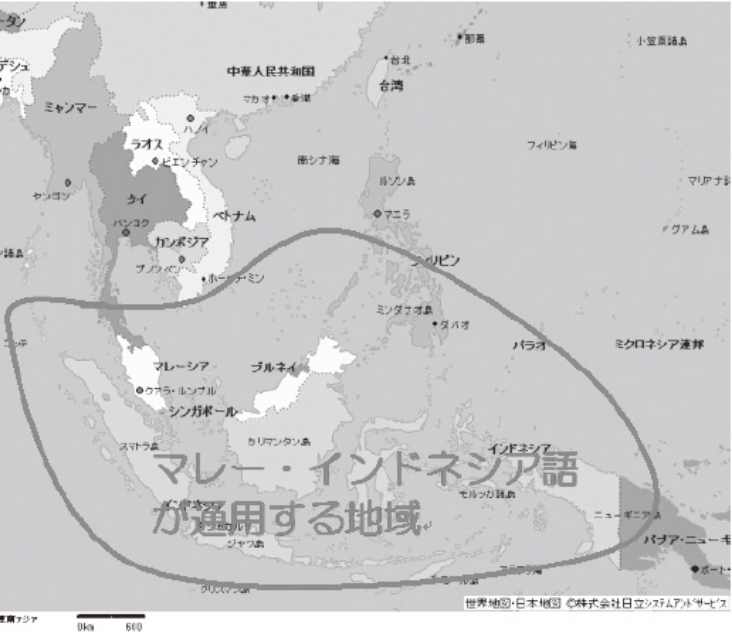
次の地図を見てください。
太い線で囲んである地域が、マレー・インドネシア語が通用する地域です。とっても広いでしょう? そう、マレー・インドネシア語が通用する地域は東南アジアのほぼ半分の面積にも相当するのです。このなかには、インドネシア共和国、マレーシア連邦、シンガポール共和国、ブルネイ・ダルサラーム国、東ティモール民主共和国、そしてフィリピン共和国の南部とタイ王国の南部、それにパプアニューギニア独立国の一部が含まれています。このうち、先に挙げたインドネシアから東ティモールまでの5カ国ではこの言葉が国語ないしは公用語として使われているのです。
東南アジアには現在11の国家がありますから、マレー・インドネシア語はほぼその半分の国で使われているということになりますね。ここまで聞けば、もう皆さんにはマレー・インドネシア語がけっしてマイナーな言語ではないことがお分かりいただけたと思います。これら5カ国とその周辺地域に住む人々の総人口はおよそ3億人ですから、日本の総人口の約2.5倍以上の人々がこの言葉を話しているということになります。
では、これほどに広い地域で通用する言葉が日本ではそれほど知られていないのはなぜでしょうか?また、なぜ他の大学ではマレー・インドネシア語という名称を使わないのでしょうか?
じつは、他の多くの大学では「インドネシア語」ないしは「マレーシア語」と呼んでいるのです。この言葉はインドネシア共和国では国語とされていて、「インドネシア語」(Bahasa Indonesia)と呼ばれています。
一方、お隣のマレーシア連邦ではこの言葉を「マレーシア語」(Bahasa Malaysia)と呼んで、やはり国語に制定しています。さらにこれら2カ国以外に、シンガポール共和国とブルネイ・ダルサラーム国でもそれぞれ国語と定めており、これらの国々では「マレー語」(ムラユ語)(Bahasa Melayu)と呼んでいます。名称はさまざまですが、国による違いは比較的少なく、ひとつの地域の言葉に習熟すると、他の地域に行っても、ちょっとした語彙の違いさえ克服すればそれほど不自由することはありません。その違いは、ちょうどアメリカ英語とイギリス英語の違いのようなものと考えていただければいいと思います。SFCでは、このような事情を考慮に入れて、これらすべての地域に通用する言葉を学んでもらおうと考え、「マレーシア語コース」でもなく、「インドネシア語コース」でもなく、「マレー・インドネシア語コース」と名づけたのです。本コースでは主としてインドネシア地域の言葉を学んでもらいますが、熟達すればマレーシアなどの言葉を理解するのは容易です。
科目ごとの授業内容
SFCのマレー・インドネシア語プログラムはインテンシブ、ベーシック、スキルおよび海外研修の各コースを提供しています。
1. インテンシブ(週4回 4単位)
インテンシブコースは、SFC創設当初から継続して開講されている、いわばマレー・インドネシア語プログラムの中心的コースです。このプログラムは、インテンシブ1、インテンシブ2、インテンシブ3の3つのレベルに分けられています。インテンシブ1、インテンシブ2は、学期中に開講され、週4回の授業で、集中的かつ効率的にインドネシア語の標準的な能力を身につけることを目指します。またインテンシブ3は、春休み、または夏休み期間中にインドネシアで開講されるクラスです。これらのクラスでは、文法、語彙構築、講読、会話、およびライティングスキルなど多くの面からマレー・インドネシア語を学ぶことができます。同時に、色々な専門を持つ講師陣たちから、インドネシアやマレーシアの社会、文化についても学ぶことができます。
① インテンシブ1
インテンシブ1は、言語の概要に関する基本的知識を習得することから始め、マレー・インドネシア語の基本的な能力を養うことに重点が置かれています。授業では基本的な文法、会話、および語彙構築を重点的に学びます。このレベルを修了した学生は最低限のマレー・インドネシア語で簡単な会話をすることができるようになります。
履修要件なし
② インテンシブ2
このクラスはインテンシブ1、またはベーシック2を修了した学生を対象としており、マレー・インドネシア語プログラムの中級レベルのクラスです。このレベルでは文法、会話、語彙構築、読み書きのスキルを中心に学びます。このレベルを修了すると、専門分野の論文執筆や専門書の読解はまだやや困難かもしれませんが、学生はマレー・インドネシア語で自分の考えや見方などをかなり自由に表現できるだけの能力を習得することができます。
履修要件インテンシブ1、またはベーシック2を修了していること。
③ インテンシブ3(春休み、夏休みにインドネシアでの開講4単位)
インテンシブ2修了後は、春休み、または夏休み期間中に、インドネシアの大学において開講されるインテンシブ3に参加することが出来ます。このクラスは、履修希望者が4人以上いた場合に開講されます。
履修要件インテンシブ2を修了していること
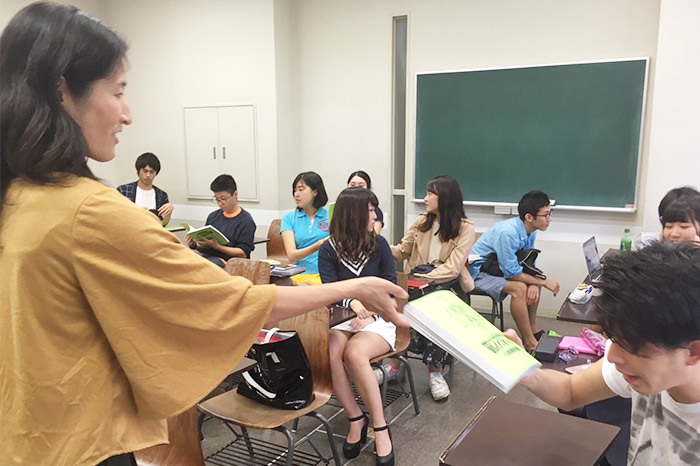
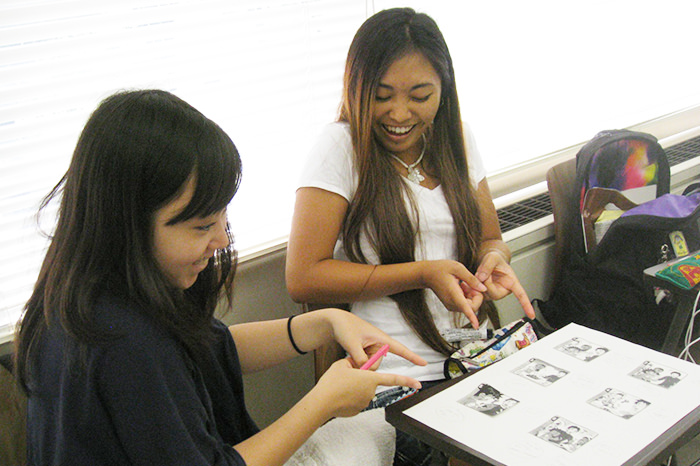
2. ベーシック(週2回 2単位)
ベーシックコースは、基礎的なマレー・インドネシア語能力をじっくりと時間をかけて学びたい学生向けに開講します。このコースは、ベーシック1、ベーシック2の2つのレベルに分けられており、週2回のペースで、簡単な会話と基本的な文法を中心に学びます。ベーシック2を修了すると、インテンシブ1を修了したのと同じレベルの能力を身につけることができます。
① ベーシック1
ベーシック1では、インドネシア語の初歩を学びます。インテンシブコースで本格的にマレー・インドネシア語を学ぶ前に、言語に触れてみたい人には向いているクラスです。このクラスでは、語彙構築、簡単な会話、および基本的な文法説明に焦点を当てています。さらに、学生はまた簡単ながらマレーシアやインドネシア社会ないし文化の側面をも学ぶことができます。
履修要件なし
② ベーシック2
ベーシック2は、ベーシック1を修了した学生を対象にしたクラスです。初級レベルでもやや複雑な文法や、中級レベルに進むために必要な会話の言い回しを学びます。単語の数も、ベーシック1より格段に増えます。このレベルを修了すると、インテンシブ1を修了したのと同じ程度のマレー・インドネシア語能力を身につけることができます。
履修要件ベーシック1を修了していること。
3. スキル(週1回 2単位)
スキルクラスは、インテンシブ2を修了した学生を対象としています。さらに進んでマレー・インドネシア語の運用能力を高め、将来、同地域で活躍する上での実践的な語彙や社会情勢などを学びます。インドネシア語の表現力や読解力を高めると共に、インドネシア社会や文化に対する理解を深めることを目的とします。現在、スキルは一学期に2種類(読解に重点を置いたクラスと会話力向上を目指すクラス)が開講されています。スキルクラスは、2 種類を同時に履修することも、継続して毎学期履修することも可能です。
履修要件インテンシブ2を修了していること。
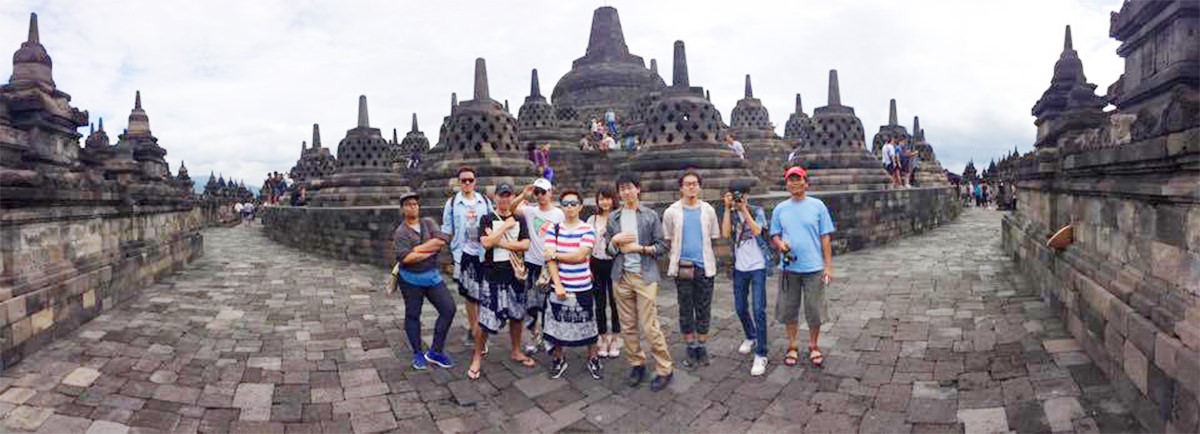
4. 海外研修(春休み、夏休み開講2単位)
春休みと夏休みには、現地でマレー・インドネシア語を勉強するために、海外研修コースを開講しています。ベーシッククラスまたはインテンシブクラスで最低1学期間学び、修了した学生は、この海外研修に参加することができます。約1か月間、現地の家庭にホームステイしながら大学に通い、ネイティブの先生方やチューターのインドネシア人学生たちと共にインドネシア語を学びます。この海外研修に参加し、所定の成績を修めると2単位が認められます。なお今年度の研修予定地は、インドネシア共和国中部ジャワの高原都市サラティガにあるサティア・ワチャナ大学(Satya Wacana)です。
履修要件ベーシック、またはインテンシブのクラスを最低1学期間履修していること。
5. 参考:マレー・インドネシア語関連講義科目
SFCでは、マレー・インドネシア語の諸クラスの他、マレーシア、インドネシアあるいは東南アジア地域のさまざまな側面を学びたいという学生のために、いくつかの一般講義科目と研究会が設けられています。一般講義科目では、たとえば、インドネシア地域論、インドネシア文化論、マレー社会論、地域と文化、などの科目があり、マレー・インドネシア語の教員たちによって教えられています。また、マレー・インドネシア語コース責任教員の野中葉研究会⑴⑵は、インドネシアをはじめとする東南アジア諸地域の社会や文化を専門的に研究したい学生向けの研究会です。これらの科目は、マレー・インドネシア語を履修していなくても履修することは可能ですが、語学の学習と並行して学べば、当該地域に関するより深い知識を得ることができるでしょう。詳細は、各科目のシラバスを参照して下さい。
授業体系図
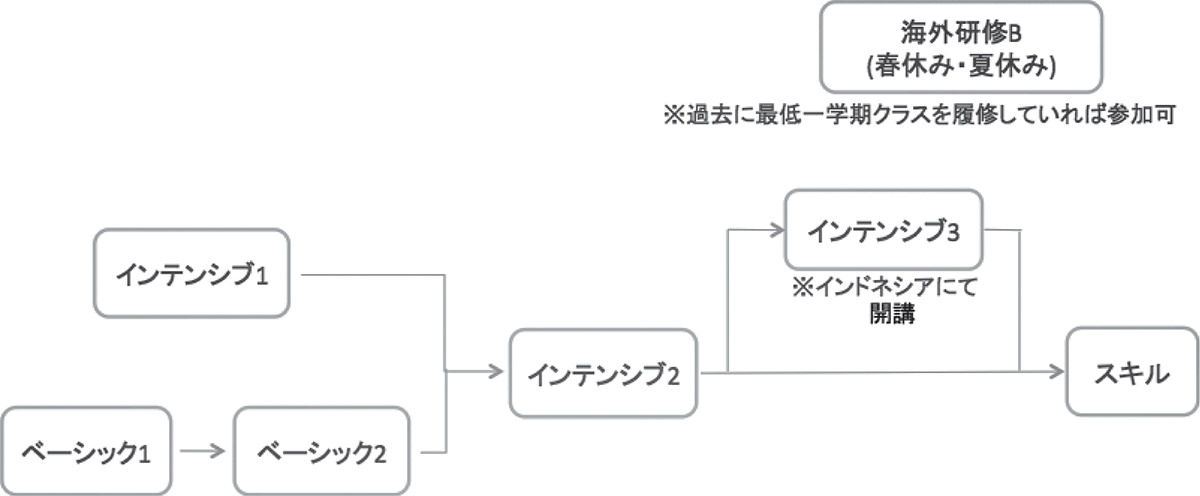
教員スタッフ
- 野中 葉
- 准教授、現代インドネシア研究、イスラームと女性研究
- ペトルス・アリ
- 訪問講師(招聘)、言語コミュニケーション、外国語教育
- 二重作 和代
- 非常勤講師、地域研究、現代インドネシア研究
- バンバン・ルディアント
- 非常勤講師、経済学、防災研究
- エリカ・フロレンティナ
- 非常勤講師、日本研究、日本文化
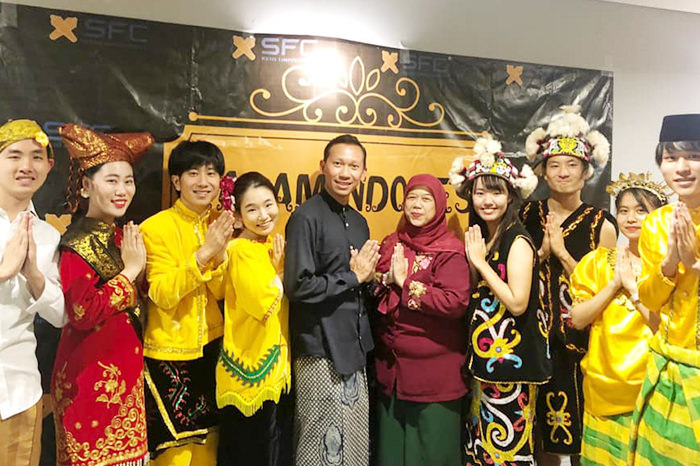

Introduction
"Selamat datang!" to the Malay-Indonesian Lab.
Selamat datang! We challenge you to try to pronounce this phrase. It means "Welcome!" in Malay-Indonesian. It's nearly understandable to native speakers if you pronounce it as it is written in Katakana (スラマット・ダタン). So, we anticipate that those who can speak some Japanese will not find Malay-Indonesian pronunciation to be difficult.
Malay-Indonesian language

Take a look at this map.
Malay-Indonesian is spoken in the area circled in a bold line. It's a very large area, isn't it? The area where Malay-Indonesian is spoken is equivalent to almost half the area of Southeast Asia. The area includes Republic of Indonesia, Malaysia, Republic of Singapore, Brunei Darussalam, The Democratic Republic of Timor-Leste, the southern part of Republic of the Philippines, the southern part of Kingdom of Thailand, and part of Independent State of Papua New Guinea. In five out of the aforementioned countries, from Indonesia to Timor-Leste (East Timor), Malay-Indonesian is used as the national or official language.
There are currently 11 nations in Southeast Asia, which means that Malay-Indonesian is spoken in almost half of them. You have probably realized by now that Malay-Indonesian is not a minor language at all. Approximately 300 million people in total are living in these five countries and the surrounding areas, which means that Malay-Indonesian speakers number more than 2.5 times the total population of Japan.
One may wonder, why is a language that is spoken in such a wide region not well known in Japan? And why don't other universities use "Malay-Indonesian" for the course name?
In fact, many universities call it "Indonesian" or "Malaysian" course. That's because it is the national language of Republic of Indonesia, where it is called "Indonesian" (Bahasa Indonesia), and is called "Malaysian" (Bahasa Malaysia) in Malaysia, where it is also a national language.
In addition to these two countries, the Republic of Singapore and Brunei Darussalam have designated it as a national language, and call it "Malay" (Bahasa Melayu). Although the names vary, there are relatively few differences in language usage between countries, and once you become proficient in the language of one region, you will not have much difficulty in understanding the language in other regions, if you understand minor differences in vocabularies. The difference will be just like the difference between American and British English. Taking this circumstance into consideration, we named the course the "Malay-Indonesian language course," rather than calling it the "Malay course" or the "Indonesian course". so that students understand that they are learning a language that is used in all these regions. Although students will mainly learn the variant from the Indonesian region, it will become easier for them to understand the language of other regions such as Malaysia, once they become proficient.
Course Contents
The SFC's Malay-Indonesian Lab offers courses including Intensive, Basic, Skill as well as study abroad programs.
1. Intensive Course (4 times a week; 4 credits)
The Intensive course, which has been offered at SFC since its establishment, is the core of the Malay-Indonesian courses. The course is divided into three levels, Intensive 1-3. Intensive 1 and 2 are offered during the semester, have four classes a week, and are designed to develop standard Indonesian language skills intensively and efficiently. Intensive 3 is offered in Indonesia during spring or summer break. In these courses, students learn Malay-Indonesian through multifaceted approaches including grammar, vocabulary-building, reading, conversation, and writing skills. Students will also be able to learn about Indonesian or Malaysian society and culture from instructors with a variety of expertise.
① Intensive 1
In Intensive 1, students begin acquiring fundamental knowledge of Malay-Indonesian focusing on developing basic ability in the language. Classes focus on simple grammar, conversation, and vocabulary building. Students who completed this level will acquire the minimum Malay-Indonesian required to be able to have simple conversations.
There are no requirements to take this course.
② Intensive 2
This course is the intermediate level of the Malay-Indonesian course, and is intended for students who have completed Intensive 1 or Basic 2. We focus on grammar, conversation, vocabulary building, reading and writing. Upon completing of this level, students will have acquired enough proficiency to express their thoughts and views freely in Malay-Indonesian, although it may be somewhat difficult to write papers in specialized fields or read technical books.
Prerequisite course: Intensive 1 or Basic 2
③ Intensive 3 (to be held in Indonesia during spring or summer break; 4 credits)
Upon completion of Intensive 2, students are able to participate in Intensive 3, which is offered at a university in Indonesia over spring or summer break. This course is offered when there are four or more students who wish to participate in.
Prerequisite course: Intensive 2


2. Basic Course (twice a week; 2 credits)
The Basic course is for students who wish to take their time learning basic Malay-Indonesian. This course is divided into two levels, Basic 1 and Basic 2. The class meets twice a week and focuses on simple conversation and basic grammar. Upon completion of Basic 2, students will have acquired an equivalent level of proficiency as those who have completed Intensive 1.
① Basic 1
In Basic 1, students learn rudimentary Indonesian. This course is for students who want to experience Malay-Indonesian before fully engaging in the language in the Intensive course. The course focuses on vocabulary building, simple conversation, and basic grammar. In addition, students can also learn a little about the society and culture of Malaysia and Indonesia.
There are no requirements to take this course.
② Basic 2
Basic 2 is for students who completed Basic 1. Beginner-level students learn more complex grammar and conversational phrases necessary to advance to the intermediate level. The number of vocabulary words they learn will increase significantly when compared to Basic 1. Upon completion of this level, students will have acquired an equivalent level of proficiency as those who have completed Intensive 1.
Prerequisite course: Basic 1
3. Skill Course (once a week; 2 credits)
The Skill course is for students who have completed Intensive 2. Students further develop their Malay-Indonesian language skills. learning practical vocabulary and the social background that will allow them to work as a professional in Malay-Indonesian-speaking regions in the future. The purpose of this course is to improve students' ability to comprehend and express themselves in Indonesian, as well as to deepen their understanding of Indonesian society and culture. Currently, the Skill course offers two options in a semester (a course focusing on reading comprehension and the other focusing on conversational ability). Students may take both courses in the same semester or take them in consecutive semesters.
Prerequisite course: Intensive 2

4. Short-Term Study Abroad Course (offered during spring/summer break; two credits)
The study abroad course is offered for students to study Malay-Indonesian in the countries it is spoken during spring and summer breaks. Students who have taken and completed at least one semester of the Basic or Intensive course may participate in the study abroad course. Participants stay with a local family for one month while attending classes in a university to learn Indonesian with native Indonesian speaking teachers and student tutors. Students who participated in this program and achieved the prescribed grades will receive two credits. This year, the program will take place at Satya Wacana Christian University in Salatiga in Central Java, Republic of Indonesia.
Prerequisite course: Basic or Intensive course taken at least for one semester
5. Reference: Lecture courses related to Malay-Indonesian language
In addition to the Malay-Indonesian language courses, SFC offers several lecture courses and Kenkyukai research seminars for students who wish to learn about various aspects of Malaysia, Indonesia, or Southeast Asia. Lecture courses include Indonesian Regional Studies, Indonesian Cultural Studies, Malay Social Studies, and Region and Culture. Courses are taught by Malay-Indonesian language instructors. Kenkyukai, taught by Prof. Nonaka who oversees the Malay-Indonesian Language Lab, is for students who wish to specialize in the society and culture of Southeast Asia including Indonesia. Students may take these courses even without taking any Malay-Indonesian language course. However, they will be able to gain deeper knowledge of the region if they take the language courses in parallel with these courses. For details, please refer to the syllabus of each course.
Class System Diagram

Faculty members
- Yo Nonaka
- Associate Professor; contemporary Indonesian studies, Islam and women's studies
- Petrus Santoso A
- Visiting Lecturer (Full-time); language communication, foreign language education
- Kazuyo Futaesaku
- Part-time lecturer; Area Studies, contemporary Indonesian studies
- Rudyanto Bambang
- Part-time lecturer; economics, disaster prevention studies
- Erika Florentina A
- Part-time lecturer; Japanese studies, Japanese culture

